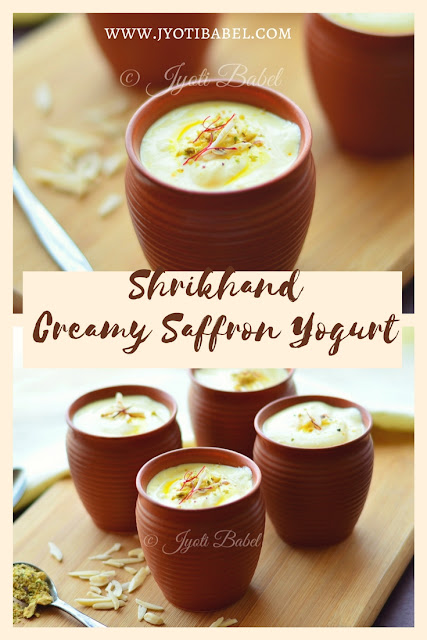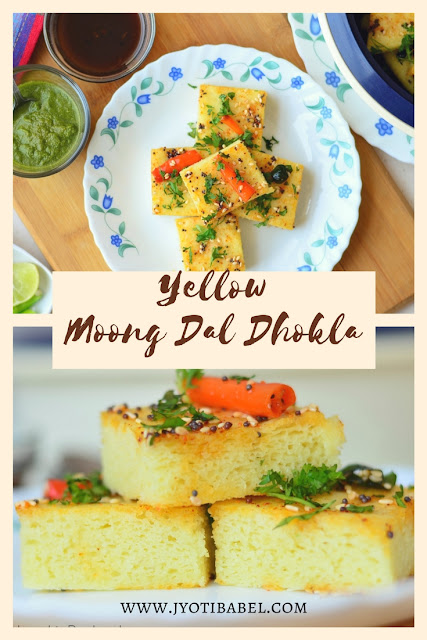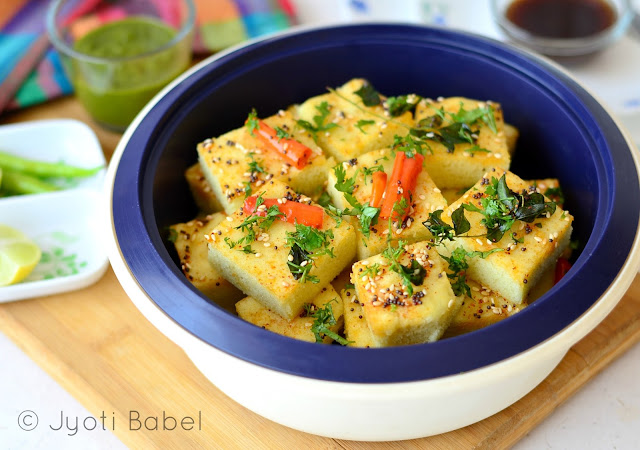Shrikhand is the Indian flavoured thick yogurt. It is typically flavoured with cardamom and saffron. But, you can get as creative as you like. Flavoured yogurts are a rage these days, specially fruit flavoured ones. But, for me when it comes to flavoured yogurt, it has to be the traditional Indian Shrikhand. Although it is eaten throughout the country these days, it is said to be native to the states of Gujarat and Maharashtra.
I don't like the ready to eat shrikhand you get in most supermarket aisles - they are made too sweet and seem to have some artificial flavor. The good news is that it is so easy to make Shrikhand at home. Serve it with your regular meal or make it as a dessert for a party menu - it will shine on both occassions. It is good for your gut and a must-have in these hot summer days.

It is just that you have to plan it advance as you are going to need hung yogurt/curd for making it. If you can get your hands on Greek yogurt, you can whip this up in no time.
Looking for some other dessert ideas with yogurt check out, Mango Shrikhand (Amarakhand), Mango Yogurt Delight, Misti Doi and Blueberry Fool.
Making hung yogurt/curd is pretty easy too - but, it takes some time.
2. Pour into individual serving bowls. Garnish with chopped pistachio and flakes almonds. Let it rest in refrigerator and take it out at the time of serving. Serve chilled.

1. You can also pass the yogurt mixture through a sieve for best results. But, it will be a bit messy with a couple of more utensils to wash.
2. Do not using a electric blender to mix it as it tends to liquefy the yogurt. You can however use an electric whisk to make things easier.
Making hung yogurt/curd is pretty easy too - but, it takes some time.
Here is how you can make hung curd.
Line a sieve with muslin cloth and pour your regular yogurt over it. Cover with a lid and leave it in your fridge for 3-4 hours- overnight is even better. The whey from the yogurt will drain out slowly leaving behind a thick creamy hung yogurt/curd. If you have 2 cups of yogurt you will get about 3/4 or at most 1 cup hung curd.
Shrikhand Recipe | How to Make Shrikhand from Scratch
Ingredients:
450 ml hung curd ( made from 1 liter of regular full fat homemade curd)
1/4 cup + 2 tbsp powdered sugar ( adjust to taste - you may like it more or less sweet)
3-4 cardamom pods, finely powdered
10 saffron strands, soaked in 1 tsp milk and rubbed in a pestle and mortar.
Chopped pistachios and flaked almonds for garnishing.
Process:
1. In a large bowl add the hung curd, sugar, powdered cardamom and rubbed saffron. Using a whisk, mix everything together till all the ingredients are well blended and the yogurt is smooth and creamy.
Shrikhand Recipe | How to Make Shrikhand from Scratch
Ingredients:
450 ml hung curd ( made from 1 liter of regular full fat homemade curd)
1/4 cup + 2 tbsp powdered sugar ( adjust to taste - you may like it more or less sweet)
3-4 cardamom pods, finely powdered
10 saffron strands, soaked in 1 tsp milk and rubbed in a pestle and mortar.
Chopped pistachios and flaked almonds for garnishing.
Process:
1. In a large bowl add the hung curd, sugar, powdered cardamom and rubbed saffron. Using a whisk, mix everything together till all the ingredients are well blended and the yogurt is smooth and creamy.
2. Pour into individual serving bowls. Garnish with chopped pistachio and flakes almonds. Let it rest in refrigerator and take it out at the time of serving. Serve chilled.

Notes:
1. You can also pass the yogurt mixture through a sieve for best results. But, it will be a bit messy with a couple of more utensils to wash.
2. Do not using a electric blender to mix it as it tends to liquefy the yogurt. You can however use an electric whisk to make things easier.
Thank you for stopping by! Cheers!











